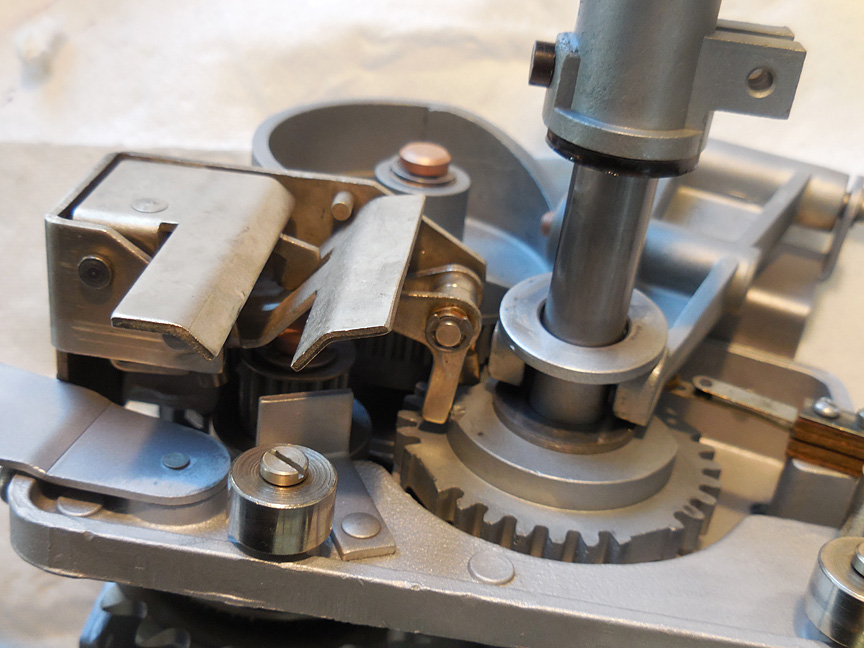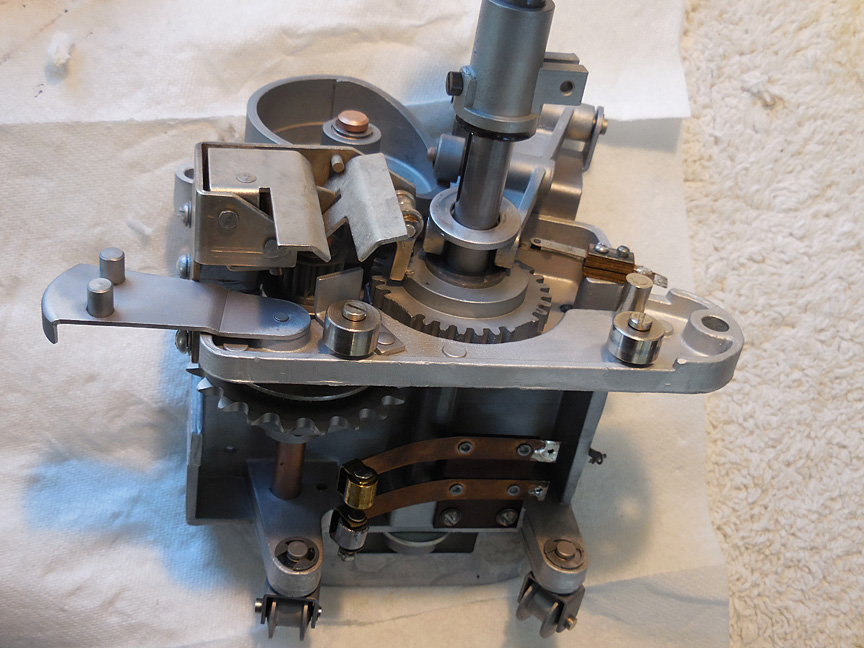Contents:
Introduction
Play
General Description, Components
How It Works
History
Restoration Part 1
Restoration Part 2
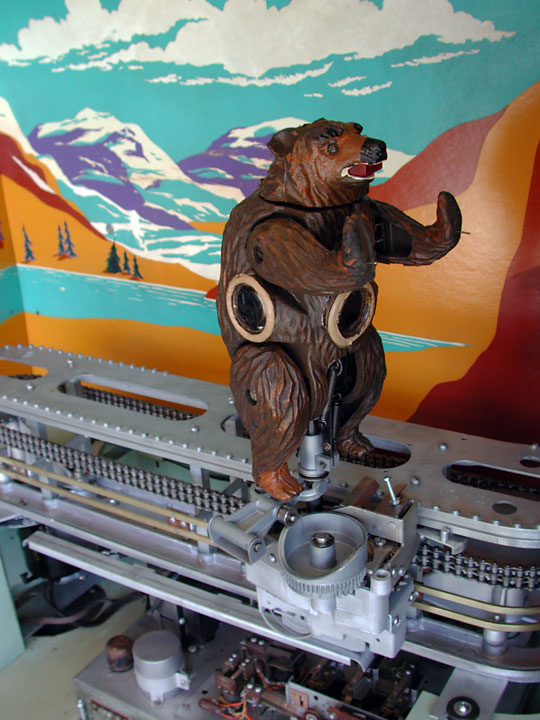
How the Game Mechanism Works
What makes the bear move and stop when he is hit. He rises up to stand on his hind feet, turns and looks at the shooter with his eyes and mouth lit up red, and then growls. He then turns the other direction, drops back down on to all four feet, and takes off running again. His dog, once chasing the bear, is now running for his life!
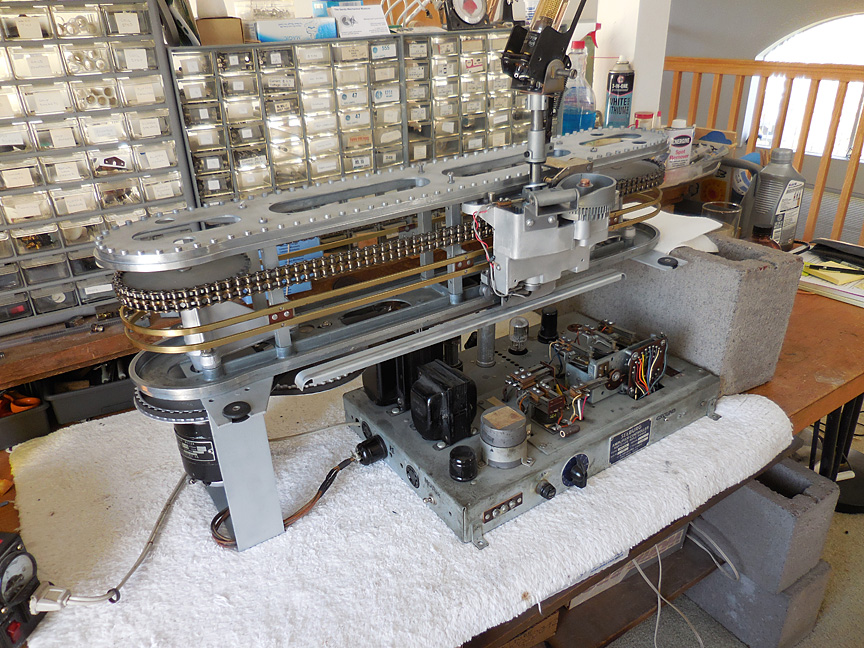
The test setup shows the track with the amplifier underneath. The bear carriage is mounted and the bear frame without the bear is attached. The chain is driven by the motor in the bottom left. The amplifier supplies the motor and determines which direction the motor rotates.
The carriage has a chain sprocket that engages the chain. There is a clutch to reduce the shock when the motor changes direction. The clutch consists of two leather patches on either side of the sprocket with a pressure plate pushing them all together. The spring in the center of the picture is adjustable by a collar with set screws.
Once the chain has stopped and is ready to rotate in the opposite direction it is time to lock the carriage in place.
As the sprocket rotates the opposite direction, the geneva mechanism starts to rotate. The fingers in the center of the picture follow the cam profile and drop the flappers, the curved metal fingers on the left, onto the protrusions on the track. These keep the carriage stationary while the bear is doing his thing.
Now the bear needs to rise up and turn. Part of that happens in the above picture. The gears have straight segments which act as a geneva mechanism. The bear hesitates at the stop of his turn which is accomplished by the bear stopping for an instant.
The cam in the upper left rotates and a yoke causes the bear to rise up. Once the rotation is finished, the cam will continue to rotate, allowing the bear to come down. The flapper ratches disengage and the bear resumes his run in the opposite direction.
Video on How the Mechanism Works
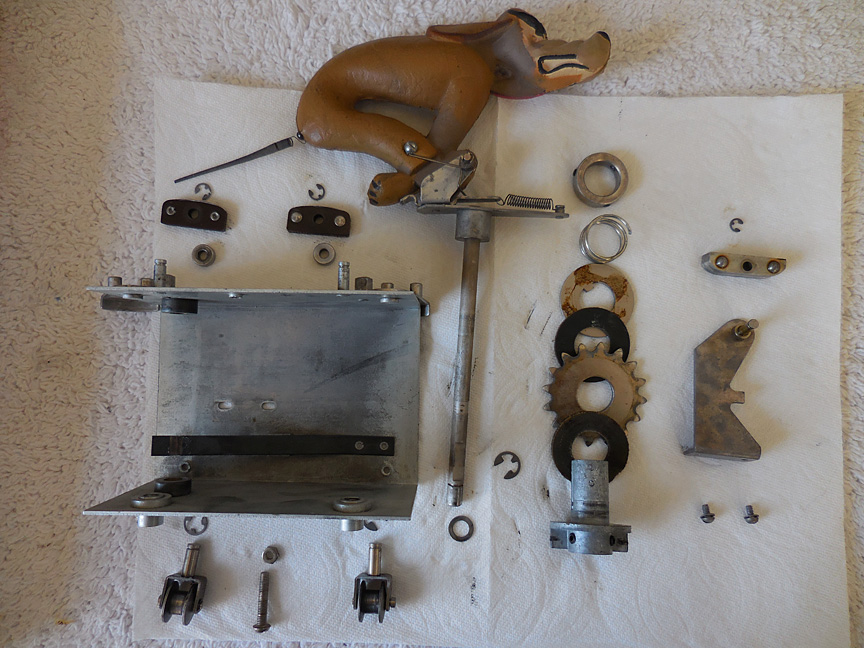
This shows the parts of the dog. Notice that it also has a clutch with a couple of leather patches on either side of the sprocket. The followers and wheels allow the carriage to move around the track easily. The odd shaped piece on the right controls how far the dog will turn when running either direction.
How the Game Plays
The coin mechanism is the same as those used by Seeburg in their jukeboxes during the 1950s. A coin dropped by the player causes a solenoid to push a pin against a pinwheel. This closes a contact indicating credits are available and also positions a bent blade on the pinwheel. The game will continue to provide credits until the bent blade is straightened. This happens when the blade is rotated to the top by the credit motor. The credit motor rotates every time a credit is played. The quarter coin slot triggers a pin solenoid three units from the top, providing three plays while the dime slot triggers one only one position from the top. It is possible for the operator to adjust the position of the solenoids on the pinwheel in order to accommodate various coins and denominations.
Game start
A press of the button causes the credit motor to rotate the credit pinwheel one position and resets the shot count to zero. The shot count going to zero turns on the movement motor and the bear starts to run around the track.
As the chain drags the bear around the track, pins on the bottom of his legs trip over piano wires sticking out in his path, causing them to swing back and forth. The left legs are connected to the right legs with a pivoted rod, causing them to move in opposite directions. It appears as if the bear is realistically running.
The scenery partially obscures the back part of the track, while the front part of the track is always visible. The bear appears to be running in front of the trees, and then turns and runs behind the trees. He turns around to repeat the process, traveling in an oval. Gaps in the scenery allow the player to see the bear when he is in the back portion of the cabinet but only for an instant.
The player takes careful aim. During this time, a capacitor is charging. The player pulls the trigger, causing the capacitor to discharge into a relay. While the relay is closed, electrical current is supplied to the light bulb in the gun, causing a quick beam of light.
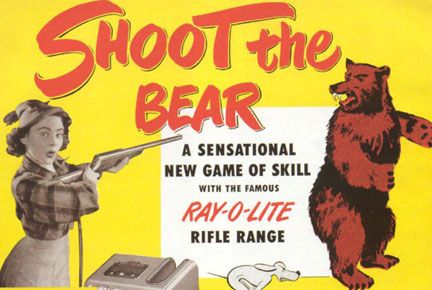
See also this larger ad which show how the game is played.
If the light enters the lens on the side of the bear, a photo tube inside the bear sends a small current pulse to an amplifier in the bottom of the cabinet. This amplifier is just like those used in jukeboxes with some modifications. The signal is amplified and causes a relay to indicate a hit, adding one to a hit-count score wheel.
In any case, the trigger pull also causes a solenoid in the cabinet to effect a shot sound, and the shot count is reduced by one on a count wheel inside the cabinet. There is special circuitry to make sure the photocell is not sensed except when a shot is happening, preventing some cheating.

Upon sensing a hit, a relay on the amplifier causes the current to the electric motor to reverse, which causes the chain to run around the track in the opposite direction. A complex set of cams and gears, cause the bear to raise up on his rear legs, and rotate. While rotating, a set of contacts supplies current to the bulb in the bearâs head, lighting his mouth and eyes. The bear finishes his rotation and returns to a running position facing the opposite direction and takes off yet again.
It is possible to hit the bear in the chest while he is rotating, causing him to pause and rotate back the same direction prior to the first hit. With careful aim and timing, the player can keep the bear standing and confused as to which way to run!
A hit also causes current to be sent to the growler circuit. This is a small neon tube connected to a single amplification tube and a speaker. It sounds like a growl when activated. There is no digital sound here.
The score wheel has additional contacts on the higher hit counts, allowing the lights behind "marksman", "sharpshooter, and "expert" to light when sufficient hits are recorded.
After twenty shots, the shot count wheel hits a limit contact, preventing further shots. The bear continues to run until it contacts a plate in the front of the cabinet and then stops. This makes sure the bear is not hiding in the back of the cabinet and is visible for the next player.


